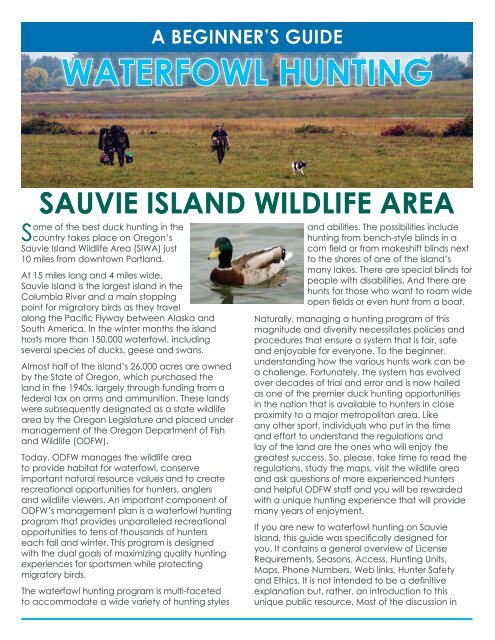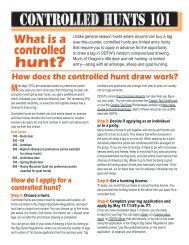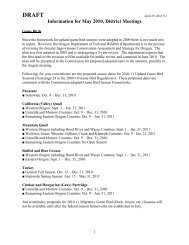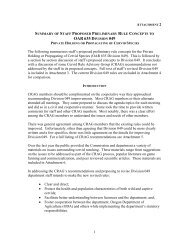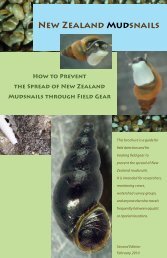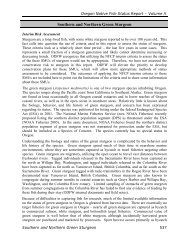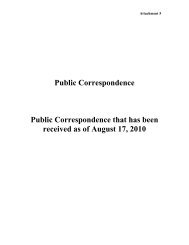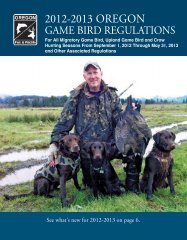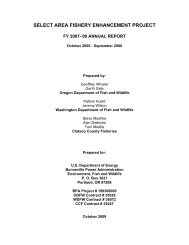a beginner's guide waterfowl hunting sauvie island wildlife area
a beginner's guide waterfowl hunting sauvie island wildlife area
a beginner's guide waterfowl hunting sauvie island wildlife area
Create successful ePaper yourself
Turn your PDF publications into a flip-book with our unique Google optimized e-Paper software.
Some of the best duck <strong>hunting</strong> in the<br />
country takes place on Oregon’s<br />
Sauvie Island Wildlife Area (SIWA) just<br />
10 miles from downtown Portland.<br />
At 15 miles long and 4 miles wide,<br />
Sauvie Island is the largest <strong>island</strong> in the<br />
Columbia River and a main stopping<br />
point for migratory birds as they travel<br />
along the Pacific Flyway between Alaska and<br />
South America. In the winter months the <strong>island</strong><br />
hosts more than 150,000 <strong>waterfowl</strong>, including<br />
several species of ducks, geese and swans.<br />
Almost half of the <strong>island</strong>’s 26,000 acres are owned<br />
by the State of Oregon, which purchased the<br />
land in the 1940s, largely through funding from a<br />
federal tax on arms and ammunition. These lands<br />
were subsequently designated as a state <strong>wildlife</strong><br />
<strong>area</strong> by the Oregon Legislature and placed under<br />
management of the Oregon Department of Fish<br />
and Wildlife (ODFW).<br />
Today, ODFW manages the <strong>wildlife</strong> <strong>area</strong><br />
to provide habitat for <strong>waterfowl</strong>, conserve<br />
important natural resource values and to create<br />
recreational opportunities for hunters, anglers<br />
and <strong>wildlife</strong> viewers. An important component of<br />
ODFW’s management plan is a <strong>waterfowl</strong> <strong>hunting</strong><br />
program that provides unparalleled recreational<br />
opportunities to tens of thousands of hunters<br />
each fall and winter. This program is designed<br />
with the dual goals of maximizing quality <strong>hunting</strong><br />
experiences for sportsmen while protecting<br />
migratory birds.<br />
The <strong>waterfowl</strong> <strong>hunting</strong> program is multi-faceted<br />
to accommodate a wide variety of <strong>hunting</strong> styles<br />
A BEGINNER’S GUIDE<br />
WATERFOWL HUNTING<br />
SAUVIE ISLAND WILDLIFE AREA<br />
and abilities. The possibilities include<br />
<strong>hunting</strong> from bench-style blinds in a<br />
corn field or from makeshift blinds next<br />
to the shores of one of the <strong>island</strong>’s<br />
many lakes. There are special blinds for<br />
people with disabilities. And there are<br />
hunts for those who want to roam wide<br />
open fields or even hunt from a boat.<br />
Naturally, managing a <strong>hunting</strong> program of this<br />
magnitude and diversity necessitates policies and<br />
procedures that ensure a system that is fair, safe<br />
and enjoyable for everyone. To the beginner,<br />
understanding how the various hunts work can be<br />
a challenge. Fortunately, the system has evolved<br />
over decades of trial and error and is now hailed<br />
as one of the premier duck <strong>hunting</strong> opportunities<br />
in the nation that is available to hunters in close<br />
proximity to a major metropolitan <strong>area</strong>. Like<br />
any other sport, individuals who put in the time<br />
and effort to understand the regulations and<br />
lay of the land are the ones who will enjoy the<br />
greatest success. So, please, take time to read the<br />
regulations, study the maps, visit the <strong>wildlife</strong> <strong>area</strong><br />
and ask questions of more experienced hunters<br />
and helpful ODFW staff and you will be rewarded<br />
with a unique <strong>hunting</strong> experience that will provide<br />
many years of enjoyment.<br />
If you are new to <strong>waterfowl</strong> <strong>hunting</strong> on Sauvie<br />
Island, this <strong>guide</strong> was specifically designed for<br />
you. It contains a general overview of License<br />
Requirements, Seasons, Access, Hunting Units,<br />
Maps, Phone Numbers, Web links, Hunter Safety<br />
and Ethics. It is not intended to be a definitive<br />
explanation but, rather, an introduction to this<br />
unique public resource. Most of the discussion in
this <strong>guide</strong> revolves around duck <strong>hunting</strong>, since that<br />
is by far the most extensive <strong>hunting</strong> opportunity on<br />
the <strong>wildlife</strong> <strong>area</strong>. There is also a short section at the<br />
end, providing a brief overview of goose <strong>hunting</strong>.<br />
License Requirements<br />
n Valid <strong>hunting</strong> license<br />
n State <strong>waterfowl</strong> validation<br />
n Hunter Information<br />
Program (HIP) validation<br />
n Federal <strong>waterfowl</strong> stamp<br />
n Sauvie Island Wildlife Area<br />
Parking Permit<br />
n Sauvie Island Wildlife Area Hunting Unit Permit<br />
n Goose hunters need a Northwest Goose Permit,<br />
except during the September season<br />
Note: Hunting licenses and state game bird validations can<br />
be purchased from ODFW offices and license agents. HIP<br />
validations are obtained free of charge at ODFW offices or<br />
license agents after answering several questions related to<br />
the harvest of game birds. Federal <strong>waterfowl</strong> stamps can be<br />
purchased at ODFW offices and U.S. Postal Service offices.<br />
SIWA parking permits can be purchased from ODFW offices<br />
and license agents. SIWA <strong>hunting</strong> unit permits are issued on<br />
hunt days at one of the Sauvie Island hunter check stations.<br />
Northwest Zone goose permits can be purchased for a<br />
nominal fee after passing a test demonstrating the ability to<br />
correctly identify different goose species.<br />
Seasons<br />
Duck Hunting<br />
Mid-October through January, varies slightly year<br />
to year<br />
Eastside Unit – Every other day (for exact dates,<br />
refer to the Sauvie Island Reservation Hunt tables,<br />
which are printed in the back of the Oregon Game<br />
Bird Regulations)<br />
Westside Unit – Every other day (same dates as<br />
Eastside Units)<br />
North Unit – Every day<br />
Goose Hunting<br />
September Canada Goose Hunt – Early to mid-<br />
September<br />
Northwest Permit Goose Hunt – Mid-October<br />
through January<br />
Shooting times<br />
Eastside and Westside units – Beginning times<br />
change each week throughout the season<br />
depending on when sunrise takes place. Official<br />
start times are listed in the shooting hours table<br />
in the Oregon Game Bird Regulations. Ending<br />
shooting times on these two units is 4 p.m. for the<br />
entire season.<br />
North Unit – Both beginning and ending shooting<br />
times are the same as official times listed in the<br />
Game Bird Shooting Hours Table in the Oregon<br />
Game Bird Regulations. In other words, North Unit<br />
both beginning and ending shooting hours change<br />
every week according to when dawn and dusk<br />
take place. This unit is closed to goose <strong>hunting</strong><br />
except during the September goose season.<br />
Access<br />
For the purposes of duck <strong>hunting</strong>, the Sauvie Island<br />
Wildlife Area is divided into three general <strong>area</strong>s –<br />
the Eastside Unit, Westside Unit, and North Unit. The<br />
Eastside and Westside units are divided into a total<br />
of 20 smaller <strong>hunting</strong> subunits. Hunters must obtain<br />
a SIWA <strong>hunting</strong> permit to hunt in any of these<br />
<strong>area</strong>s and this permit must be in their possession<br />
while they are <strong>hunting</strong>. Due to differences in the<br />
number of and types of blinds, topography, hunter<br />
demand, <strong>waterfowl</strong> distribution and other factors,<br />
each <strong>area</strong> has its own system for allocating permits.<br />
These systems are designed to give everybody an<br />
equal chance to “draw” a permit as quickly and<br />
efficiently as possible.<br />
How to Hunt the Eastside Unit<br />
Getting there – The Eastside is comprised of 14<br />
individual <strong>hunting</strong> subunits. Access to all Eastside<br />
subunits is permitted only after obtaining a SIWA<br />
<strong>hunting</strong> permit at ODFW’s Eastside check station,<br />
which is located approximately 11 miles from the<br />
Sauvie Island Bridge, at the intersection of Reeder<br />
and Rentenaar roads. To get to the check station,<br />
from Hwy. 30, cross the Sauvie Island Bridge and<br />
stay straight on Sauvie Island Road. Follow Sauvie<br />
Island Road for 2 miles until it forks. At the fork, bear<br />
right and stay on Reeder Road for 9 miles. The<br />
check station is a small light gray building on<br />
the left.<br />
Getting a SIWA Eastside <strong>hunting</strong> permit – The<br />
Eastside or “food crop” <strong>area</strong> has the greatest<br />
number of individual <strong>hunting</strong> units and is the most<br />
popular among hunters. These are lands managed<br />
to provide abundant natural foods or are planted<br />
with corn, millet, buckwheat and alfalfa to provide<br />
food and habitat for the birds and to reduce their<br />
impact on surrounding private lands. On weekends<br />
especially, there is often more demand for <strong>hunting</strong><br />
than the <strong>area</strong> can meet. That is why years ago<br />
ODFW adopted a reservation system for allocating<br />
<strong>hunting</strong> permits for Eastside subunits. Under<br />
this system, hunters have two possible ways of<br />
obtaining a permit. Those methods are as follows:<br />
Option #1 – The first method is to apply for a<br />
reservation through ODFW’s computerized<br />
controlled hunt system. Using this method, the<br />
hunter pays a small fee to participate in a random<br />
drawing that can be entered at ODFW offices,<br />
license agents or by sending in an application
EASTSIDE BLIND UNITS<br />
HUNT BLIND UNIT JOHNSON BLIND UNIT<br />
MUDHEN BLIND UNIT RACETRACK BLIND UNIT
printed in the back of the Oregon Game Bird<br />
Regulations. The hunter can choose up to five<br />
Eastside subunits in each of seven drawings<br />
conducted about every two weeks from<br />
September through December. Those who are<br />
successful in a drawing may then purchase a<br />
confirmed reservation for a small fee and take it to<br />
the check station on their hunt day and exchange<br />
it for a SIWA <strong>hunting</strong> permit. Hunters lucky enough<br />
to draw a reservation need to get themselves to the<br />
“Reservation Line” at the Eastside check station no<br />
later than 1 hour before shooting time. Beginning<br />
shooting times vary throughout the season,<br />
depending on when the sun comes up in the<br />
morning. Shooting times are listed chronologically<br />
in a table published in the Oregon Game Bird<br />
Regulations.<br />
Option #2 – The hunter can take their chances by<br />
simply driving out to the Eastside check station and<br />
getting into the “Non-Reservation Line,” which is<br />
a turnout next to Reeder Road a short distance<br />
south of the check station. Here’s how the “Non-<br />
Reservation Line” works. After everyone with a<br />
confirmed reservation is issued a tag, the check<br />
station staff issues any remaining available SIWA<br />
<strong>hunting</strong> permits on a first-come, first-served basis.<br />
This can be an effective strategy, especially during<br />
mid-week when there are often fewer hunters and<br />
less demand for <strong>hunting</strong> positions. The check station<br />
staff begins processing hunters who do not have<br />
reservations 1 hour before shooting time, assuming<br />
there are still spots available. Some hunters wait until<br />
later in the day to come to the check station and<br />
take spots vacated by other hunters.<br />
Note: With both options, anybody who receives a SIWA<br />
<strong>hunting</strong> permit for a blind is permitted to invite up to<br />
three other persons to sit in the blind. Likewise, those who<br />
receive roam permits may be accompanied by one<br />
other person, but that person may not hunt.<br />
What’s available in the Eastside Unit<br />
If you are lucky enough to get a SIWA <strong>hunting</strong><br />
permit, one of the things you’ll want to know is<br />
something about the types of <strong>hunting</strong> positions that<br />
are available. Basically, your choices are to hunt<br />
from a fixed location in blinds built and maintained<br />
by ODFW staff and volunteers or to hunt in a “roam”<br />
unit where hunters are free to walk around or build<br />
their own makeshift blind with a camouflage net<br />
and/or natural materials.<br />
The Eastside is comprised of 14 individual <strong>hunting</strong><br />
subunits. The number of hunters allowed in each of<br />
these units varies through the season. Five of the 14<br />
are “blind” subunits and the other nine are “roam”<br />
subunits, as follows:<br />
Eastside Blind Subunits<br />
n Hunt (8 regular blinds, 1 ADA accessible blind)<br />
n Johnson (5 slotted tree/vegetation blinds &<br />
2 lakeside blinds)<br />
n Mudhen (12 regular blinds, 1 ADA accessible blind)<br />
n Oak Island (6 seasonal blinds, best for ducks when<br />
water is high)<br />
n Racetrack (5 regular blinds)<br />
Eastside Roam Subunits<br />
n Aaron (up to 10 hunters)<br />
n Deadwillow (up to 10 hunters)<br />
n Footbridge (up to 8 hunters)<br />
n Malarky (up to 10 hunters)<br />
n McNary (up to 20 hunters)<br />
n Pope Lake (up to 8 hunters)<br />
n Reeder (1 party of up to four hunters)<br />
n Rentenaar (up to 10 hunters)<br />
n Stutzer (up to 8 hunters)<br />
All Eastside subunits except Hunt, Johnson, Oak<br />
Island, Mudhen and Racetrack are “roam” <strong>area</strong>s<br />
in which hunters are free to set up at any location<br />
so long as they do not interfere with hunters<br />
already in place. In the five “blind” units, hunters<br />
are required to shoot from fixed locations where<br />
there are bench style <strong>hunting</strong> blinds that have<br />
been camouflaged with corn stalks, branches and<br />
other materials. Two of these subunits have blinds<br />
reserved for individuals with disabled<br />
hunter permits.<br />
Hunters who enjoy <strong>hunting</strong> from a boat should<br />
consider Aaron, McNary or Malarky subunits.<br />
Hunters are also allowed to check into the Crane<br />
subunit through the Eastside check station,<br />
although the subunit is located in the Westside Unit.<br />
This is only allowed if hunt locations remain after<br />
the random drawing on the Westside Unit has<br />
been completed.<br />
One of two <strong>waterfowl</strong> <strong>hunting</strong> blinds reserved for individuals<br />
with disabled hunter permits.
How to hunt the Westside Units<br />
Getting there – The Westside is comprised of six<br />
individual <strong>hunting</strong> units. Access to all Westside units<br />
is through written SIWA <strong>hunting</strong> permits issued on<br />
hunt days at ODFW’s Westside check station, which<br />
is located 9 miles from the Sauvie Island Bridge. To<br />
get to the check station from Hwy. 30, cross the<br />
Sauvie Island Bridge stay straight on Sauvie Island<br />
Road. Follow Sauvie Island Road for 2 miles and<br />
stay left when the road forks. At the fork, continue<br />
on Sauvie Island Road an additional 7 miles to<br />
where it dead-ends at a gravel parking lot with a<br />
gate. The check station is a small white trailer just<br />
beyond the gate. All six <strong>hunting</strong> units are accessed<br />
from that point. Two of these units, Crane and<br />
North Crane, can also be entered by boat via the<br />
Multnomah Channel and Gilbert River, but only<br />
after first obtaining a SIWA <strong>hunting</strong> permit at the<br />
check station.<br />
Getting a SIWA Westside <strong>hunting</strong> permit – Access<br />
to the Westside units is by “luck of the draw” at the<br />
beginning of each <strong>hunting</strong> day. Hunters who are<br />
in line on the road leading to the check station<br />
no later than 1 1/2 hours before shooting time are<br />
eligible to participate in a drawing that determines<br />
who gets to pick the available <strong>hunting</strong> units first.<br />
Each person who is in line on time is given the<br />
opportunity to draw a numbered poker chip from<br />
a bag full of chips carried by ODFW staff. The<br />
person with the lowest number gets first pick of all<br />
available <strong>hunting</strong> positions. The person with the<br />
second lowest number gets second pick, and so<br />
forth, until all of the <strong>hunting</strong> positions are assigned.<br />
Hunters who do not draw a low enough number<br />
to pick one of the available positions have three<br />
choices: 1) They can go home and try another<br />
day, 2) they can wait around and get in line for a<br />
position once it is vacated by the winner, or 3) if<br />
they know one of the winners they can hope for<br />
an invitation because hunters who draw blinds can<br />
take up to three other people along on their hunt.<br />
Once hunters have drawn poker chips they are<br />
called to the check station for permits over a low<br />
power radio signal that can be heard by tuning in<br />
to Channel 1580 on their AM radio dial.
Hunters put out decoys<br />
at Mud Lake and wait for<br />
ducks at their blind next to<br />
the shore.<br />
Decoys can be very<br />
effective at attracting ducks<br />
but should be placed no<br />
farther than 35 yards from<br />
the blind to prevent shots<br />
that are too long that could<br />
result in wounded or<br />
lost <strong>waterfowl</strong>.<br />
What’s available on the Westside<br />
The Westside is comprised of six subunits, four of which<br />
contain blinds and two that are roam subunits.<br />
Westside Blind Subunits<br />
n Holman Point (6 blinds)<br />
n Mud Lake (14 blinds)<br />
n Seal (6 blinds)<br />
n Steelman (10 blinds)<br />
Westside Roam Subunits<br />
n Crane (5 parties of up to four hunters each)<br />
n North Crane (1 party of up to four hunters)<br />
The Seal, Steelman and Mud Lake subunits contain<br />
“designated shooting sites” marked by posts while<br />
Crane and North Crane are roam <strong>area</strong>s. Holman<br />
Point is an <strong>area</strong> containing designated shooting<br />
sites. The sites are “slots” where the vegetation has<br />
been trimmed to allow pass shooting as birds move<br />
between the Sturgeon Lake Refuge and the Eastside<br />
unit. These slots are bordered by the Gilbert River on<br />
the north, Sturgeon Lake Refuge on the south and<br />
large ash trees on either side. This generally means no<br />
water in which to set decoys, except during periods<br />
of extremely high water. Hunters must take care to<br />
avoid shooting into or setting decoys in the Sturgeon<br />
Lake Refuge when <strong>hunting</strong> Holman Point. While<br />
Holman Point is generally not a steady producer it<br />
can be red hot on stormy days when the birds are<br />
constantly moving and poor visibility keeps them low.
WESTSIDE BLIND UNITS<br />
HOLMAN POINT BLIND UNIT MUD LAKE BLIND UNIT<br />
SEAL LAKE BLIND UNIT STEELMAN BLIND UNIT
How to hunt the North Unit<br />
The North Unit is one large unit that has no blinds.<br />
The entire unit is considered a roam unit. It is<br />
located at the north end of the <strong>island</strong> and can be<br />
accessed by driving 12 miles from the Sauvie Island<br />
Bridge to the end of Reeder Road. It can also be<br />
accessed by boat via Multnomah Channel and<br />
Cunningham Slough. The mouth of Cunningham<br />
Slough is located just across the Multnomah<br />
Channel from the entrance of Scappoose Bay.<br />
Choices are to set up on either the slough itself or<br />
tie up and walk to any of several lakes that can<br />
be found along the way. Launch facilities are<br />
available at the public boat ramp on Scappoose<br />
Bay or the Gilbert River boat ramp on Sauvie Island.<br />
Remember, most lakes and waterways in the North<br />
Unit are influenced by tides, so water depths are<br />
constantly changing.<br />
North Unit permit process – The North Unit is the<br />
only place on the <strong>wildlife</strong> <strong>area</strong> where hunters<br />
do not need a SIWA <strong>hunting</strong> permit (permits are<br />
voluntary). Access is open to anyone who wants<br />
to hunt, seven days a week throughout the Zone 1<br />
<strong>waterfowl</strong> season, which runs generally from about<br />
mid-October through the end of January. Before<br />
entering the North Unit, hunters may pick up a selfissue<br />
<strong>hunting</strong> permit at an ODFW kiosk at the end<br />
of Reeder Road. Fill out the top part of the permit,<br />
and put it in the drop box at the kiosk. When exiting<br />
the unit, record any harvest information on the<br />
bottom half of the permit and deposit it in the drop<br />
box. The purpose of these permits is twofold: 1) to<br />
ensure the hunters’ safety by letting ODFW staff<br />
know who is in the unit, and 2) to monitor harvest<br />
information so staff can better manage bird<br />
populations.<br />
General <strong>waterfowl</strong> <strong>hunting</strong> tips<br />
Ammunition – Only federally approved nontoxic<br />
shot is allowed for <strong>hunting</strong> on the Sauvie Island<br />
Wildlife Area.<br />
Boats – Hunting by boat is possible in the North Unit,<br />
Eastside Unit (Aaron, McNary and Malarky subunits)<br />
and on the Westside Unit (Crane and North Crane<br />
subunits). When <strong>hunting</strong> from a boat, make sure<br />
to wear personal flotation devices (PFDs) and<br />
consult tide tables, since the waters on the <strong>island</strong><br />
are tidally influenced. Some hunters also carry in<br />
canoes that they can use to retrieve birds shot<br />
down over water.<br />
Clothing – Many <strong>area</strong>s of the <strong>wildlife</strong> <strong>area</strong> are<br />
accessible with hip waders but chest waders are<br />
best. Good camouflage rain gear, including coat,<br />
hat, gloves and face mask, is very popular. Many<br />
<strong>waterfowl</strong> hunters bring a 5-gallon plastic bucket to<br />
carry gear, plus it makes an excellent chair.<br />
Decoys – Many duck hunters use decoys to attract<br />
birds. Decoys should not be placed more than 35<br />
yards from blinds to prevent “skybusting,” which<br />
is the unethical practices of shooting birds that<br />
are too far away. Skybusting can lead to lost and<br />
injured birds.<br />
Dogs – A good bird dog can be a big help when<br />
it comes to retrieving ducks. Sauvie Island Wildlife<br />
Area has a lot of lakes and wetland <strong>area</strong>s. Failure to<br />
retrieve a game animal, if possible, after it has been<br />
shot is unlawful.<br />
Duck calls – Calls can be an effective way to<br />
attract ducks. There are many educational<br />
materials that can help hunters become proficient<br />
duck callers. The best teacher is experience and<br />
watching and listening to more experienced<br />
hunters.<br />
Game bird regulations – Study the Oregon Game<br />
Bird Regulations so you are familiar with the rules of<br />
the road. These regulations are designed to protect<br />
the <strong>wildlife</strong> and to ensure your safety and the safety<br />
of the people around you!<br />
Vehicles – All vehicles entering the <strong>wildlife</strong> <strong>area</strong><br />
are required to display a valid Sauvie Island Wildlife<br />
Area parking permit. Parking permits can be<br />
purchased online, from any point of sale license<br />
agent as well as many <strong>island</strong> businesses. Portions<br />
of Sauvie Island Wildlife Area are closed to entry<br />
during the <strong>waterfowl</strong> season, except with a daily<br />
<strong>hunting</strong> permit, from Oct. 1 through April 15. Many<br />
of these <strong>area</strong>s remain closed to all public access<br />
through April 30.<br />
Wildlife identification – It is a good idea to learn<br />
about the types of <strong>waterfowl</strong> that you may<br />
encounter out in the field. Common duck species<br />
harvested on SIWA include mallard, wigeon, greenwinged<br />
teal, pintail, shoveler, ring-necked duck<br />
and common merganser. In the case of geese,<br />
hunters must take a test demonstrating that they<br />
can identify the various species of geese.
A flock of cackling and Taverner’s geese browse the tender shoots of wheat emerging from a field on the Sauvie Island Wildlife Area.<br />
Goose <strong>hunting</strong> on the Sauvie Island<br />
Wildlife Area<br />
There is some excellent goose <strong>hunting</strong> to be found<br />
on the Sauvie Island Wildlife Area. However, goose<br />
<strong>hunting</strong> is highly regulated to help reduce goose<br />
damage to surrounding private farmlands and<br />
because management is subject to international<br />
treaties. In addition, some species of geese are<br />
struggling and need protection while other species<br />
are flourishing. As a result, <strong>area</strong>s that are open to<br />
<strong>hunting</strong> can change and so can season dates. As a<br />
goose hunter, it is your responsibility to know when<br />
and where you can hunt and what species you<br />
are targeting.<br />
Goose Hunting Seasons<br />
September Canada Goose Season – early to<br />
mid-September<br />
Northwest Permit Zone Goose Season – mid-<br />
October to January, depending on harvest and<br />
other factors (check current Game Bird Regulations<br />
for exact dates and open <strong>area</strong>s). To participate<br />
in this season, in addition to all the license<br />
requirements for duck <strong>hunting</strong>, hunters must also<br />
pass a test demonstrating their ability to identify<br />
different species of geese. This test is required to<br />
protect certain species from being over-harvested<br />
and is available on-line at the ODFW Web site or<br />
can be taken in writing by appointment at<br />
ODFW offices.<br />
Goose Hunting Areas<br />
September Canada Goose Season – The entire<br />
<strong>wildlife</strong> <strong>area</strong>, except for designated refuge <strong>area</strong>s,<br />
is open for <strong>hunting</strong> during the September Canada<br />
Goose Hunt. Hunters must check in and out daily<br />
at self service check stations located at the <strong>wildlife</strong><br />
<strong>area</strong> headquarters, located two miles from the<br />
Sauvie Island Bridge at 18330 NW Sauvie Island<br />
Road, and at the Willow Bar Parking lot, located just<br />
north of the Multnomah/Columbia County line on<br />
Reeder Road. The North Unit has proved to be the<br />
most productive during this early season but other<br />
<strong>area</strong>s also provide success. Other <strong>area</strong>s which<br />
may be productive are the Crane subunit in the<br />
Westside Unit and some of the agricultural <strong>area</strong>s in<br />
the Eastside Unit.<br />
Northwest Permit Zone Goose Season – The dates,<br />
open <strong>area</strong>s and quotas for the Northwest Oregon<br />
Permit Goose season change from year to year, so<br />
hunters are advised to consult annual regulations<br />
for the most up-to-date information. Hunting during<br />
this period generally is limited to the Oak Island<br />
subunit of the Eastside Unit and the Reeder Tract.<br />
Designated shooting sites in this <strong>area</strong> are pit blinds<br />
placed in the middle of large grass seed or alfalfa<br />
fields. Check-in and check-out for this hunt takes<br />
place at the Eastside Unit check station. All goose<br />
hunters must possess a valid NW Goose Permit in<br />
addition to all other required licenses, validations<br />
and permits.
Common Sauvie Island Duck Species<br />
Mallard Widgeon Green-winged teal Pintail<br />
Shoveler Ring-necked Duck<br />
Gadwall<br />
Common Merganser<br />
For more information<br />
ODFW’s Sauvie Island Wildlife Area office<br />
503-621-3488<br />
ODFW Headquarters<br />
503-947-6000<br />
ODFW NW Region Office<br />
971-673-6000<br />
ODFW Web site<br />
www.dfw.state.or.us<br />
Waterfowl regulations, statistics, shooting hours<br />
www.dfw.state.or.us/resources/<strong>hunting</strong>/<strong>waterfowl</strong><br />
ODFW Recreation Report<br />
www.dfw.state.or.us/RR/index.asp<br />
Email<br />
odfw.info@state.or.us


